Betty's Hope

|
Betty's Hope with El
Lobo
 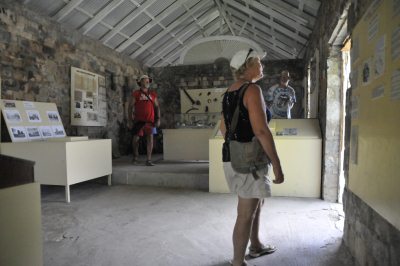 Pat reading one of the
information boards. Pat, Mike and Bear in the Visitors centre
Team Tinson left five days late
because of the ash cloud produced in Iceland - a betting person wouldn't have
gone near William Hill with that one. That left us Thursday and Friday
before Alex, Adam and Jenny arrived a week late ditto cloud. Thursday we went
with El Lobo to Deep Bay and today we started with a visit to Betty's Hope. I
have in the past put a photo of Freya of Clyde - our friends Alan and Anne but
not of El Lobo.
 So here she is, El
Lobo, a junk-rigged, ferrous hulled lady seen under sail with
Mike and Pat
 History of Betty's
Hope
Betty’s Hope was Antigua’s pioneer sugar plantation, founded in about 1650. It is now in ruins, as are so many other West Indian sugar estates. The founder of Betty’s Hope was Governor Keynell, whose widow inherited the estate upon his death in 1663, but was forced to flee Antigua during the French occupation in 1666. When Antigua was reoccupied by the British, Parliament annulled all land claims of those who had fled or been disloyal to the Crown prior to the French occupation, so in 1674, Betty’s Hope was granted to the Codrington family, then residing in Barbados.
Under the Codrington ownership, lasting until 1944, Betty’s Hope was soon transformed into one of the most efficient large-scale sugar estates in Antigua. From 1689 to 1704, two successive Christopher Codringtons served as Governors General of the Leeward Islands, and later heirs continued to be among the most influential and prosperous planters throughout the colonial era. Like other large plantations, Betty’s Hope was an agricultural as well as an industrial enterprise and home to a large number of people. Supervised by a handful of European managers, hundreds of Africans lived out their lives on this and similar plantations, first as slaves, then as labourers after emancipation in 1834. Enduring the hardship of cultivating and processing the sugar under exhausting conditions, they developed great skills as craftsmen, boilers and distillers which gave Betty’s Hope its reputation for excellence lasting to this day.
The twin windmills at Betty’s Hope worked together to crush the large volume of
sugar cane grown here.
The windmills of the early
eighteenth century used three vertical iron rollers; an inefficient system that
required two men to feed
the machine. Each cane stalk had to be crushed twice to extract as much juice
as possible. At best, this system
extracted about 60% of the juice. By the early
1800's a new system that employed three horizontally positioned rollers was
introduced. This mechanism was not only more efficient it required only one
cane feeder and extracted about 80% of the juice from the cane. The
machine installed in this mill dates to the mid-1850's and is similar to the
earlier models.
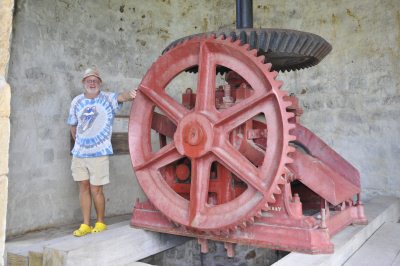
 With a steady wind, working from sunrise until
well into the night, each mill could crush sixty to seventy cartloads of cane,
or about two acres per day. The juice dripped into a tank beneath the mill and
was later piped through an underground conduit to
the boiling house. The pressed stalks, called “bagasse” were tossed out into the
mill yard to dry before being used as fuel in the boiling and distilling
furnaces. The tall, narrow opening, or
“exchange slit” on the north side of the mill was needed for changing the
central drive shaft. A lantern was kept in the small fireplace for use when
milling at night. The Restored Mill bears the original date of 1737 on a plaque
above the main entrance. It also denotes that the mill was built by Richard
Buckley. With an average trade wind, such a
mill could grind about two hundred tons of cane to produce five thousand five
hundred gallons of syrup in a week. This would have given about twelve tons
of sugar crystals. The sails would have revolved four times a minute or six to
seven in a stiff breeze while driving the crushing rollers.
Canes were brought in through the main entrance
and the squeezed pulp (begasse, used as fuel) was tossed out through the other
opening to the right. There is a fireplace high up inside. This gave light
and warmth during night shifts. The “bosun” was in charge of the mill and
the orders for starting and stopping the mill were “Turn her out” & “Turn
her in!”
 View from one of the
windmills
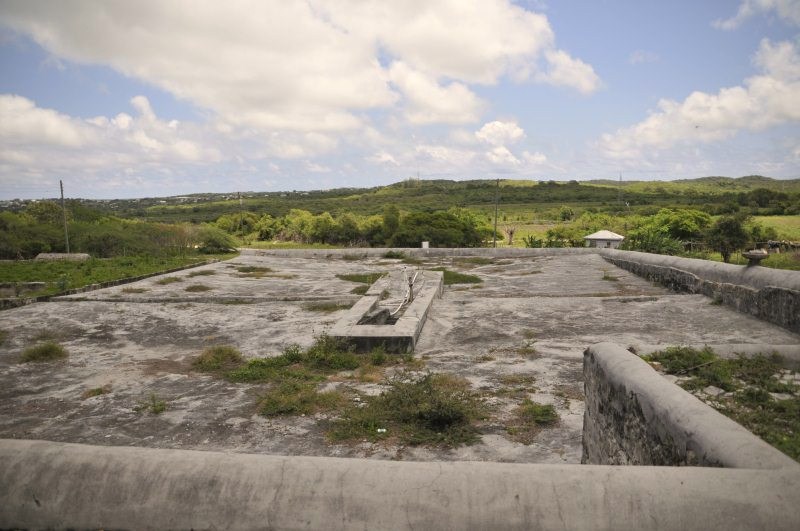 The Cistern
Complex is still in working condition, indeed, in times of severe drought
Pares villagers, up to quite recently, drew water
from its cisterns. There are four catchment areas each with
its own cistern. Notice the sundial base atop the cistern wall that borders the
entrance road. The Great House (Buff or Estate House) once
stood on the grassy knoll next to the mill. The house was surrounded by a
stone wall with dependency
buildings on each corner. In these small buildings, now disappeared, lived the
doctor, bookkeeper, overseer and a tradesman. The Curing House was where the crystals were
placed into barrels, (hogsheads) to be drained of molasses for the manufacture
of rum and for export. Today the stone from its walls have
disappeared.
The Boiling House was on a lower level, so the
cane juice could flow by gravity to the fifteen coppers, where it was
boiled until crystallisation. The Still House was where the rum was
made. This now roofless building is on a lower level and there are
magnificent arches to be admired. There is a row of cisterns along the
outside of the south wall.
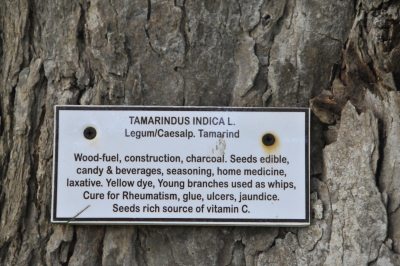 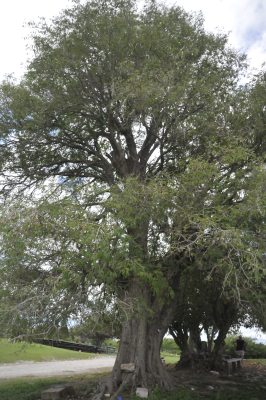 The
Tamarind tree in the grounds near where the 'big house'
stood
 What is left of the
managers house
 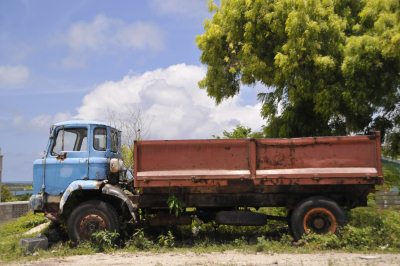 We left Betty's Hope heading to Devil's
Bridge. We found a couple of "One Careful Owner"
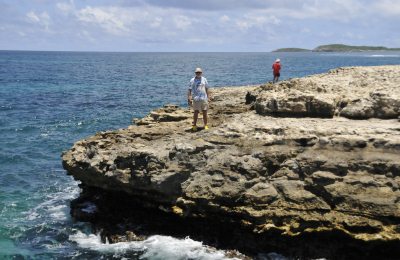 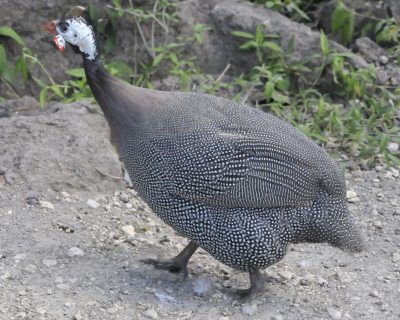 We saw much bigger
waves when we took Alex, Adam and Jenny the following week so photos on
Devil's Bridge Blog. A very silly bird- the guinea
fowl
ALL IN ALL A GOOD DAY
OUT
.
. .
|

